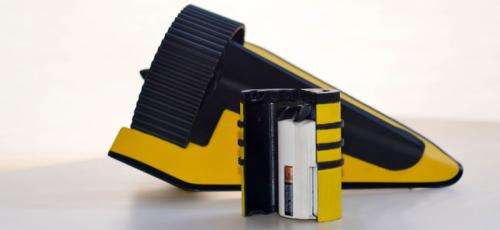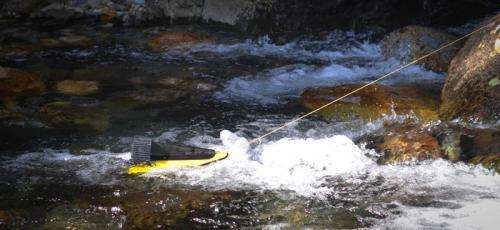November 24, 2013 weblog
HydroBee uses water from rivers or faucets to power phone (w/ Video)

(Phys.org) —Whether a person is residing off-grid, or on an outdoors adventure off-grid, finding a place to juice the smartphone is not always trivial. A Kickstarter project aims to interest people in a prototype device called the HydroBee, and its creators hope to bring it to production stage once they reach their support goals. HydroBee can power up devices with the use of water, whether drawn from rivers, streams, hoses, or faucets. Burt Hammer, one of the founders and president of Seattle-based HydroBee SPC, whose career has included working as a clean technology consultant in Southeast Asia and South America, refers to the action as charging your phone using "nature's free and renewable energy."
He and cofounder Dane Roth, vice president of product development and design, first worked together at Hydrovolts, a company Hammer founded in 2007 to make hydrokinetic turbines for big water systems. Hammer was aware of how some hands-free faucets and toilets use small turbines in water pipes to power remote sensors. He had the idea for tiny turbines for USB power, He rebuilt a small turbine from a water flow-meter and confirmed that it made over 18V from his home water faucet, enough to charge several phones. Together with Roth, they worked out the concept of the HydroBee.
HydroBee is a hydropower system that acts as a renewable USB power source. HydroBee has two parts, which offer two charging scenarios.
The device involves a tiny hydropower turbine in a can with rechargeable batteries and a USB 2.0 port. Water flowing through or around the turbine charges the batteries, delivering, as the company puts it, a can full of electric juice to go. A household water faucet with standard flow can do the job.

Then, there is the Stream Body part that can be used in streams and rivers. The turbine battery is inserted into the Stream Body. Tied to something secure, the device is lowered into a stream for two to three hours. Charging time would depend on water velocity. "Once the battery has charged, remove the Stream Body from the water, take the battery out, uncover its USB port, and enjoy a full can of nature's "juice"—clean energy for your phones, lights, and other gadgets," according to the company.
The design of the HydroBee was made using Autodesk software. They used 3D printing in a Makerbot Replicator to turn out the model at a Makerhaus workshop in Seattle. At the time of this writing, they had pledges of $9368 out of a $48,000 goal with 16 days to go. This project will only be funded if at least $48,000 is pledged by December 10. Estimated delivery is March 2014.
Also at the time of this writing, there is on offer the HydroBee turbine generator that charges batteries with water from a faucet or hose, which includes sticker and USB flash drive, for $24 or more. This does not include the floating Stream Body. For a pledge of $78 or more one receives a complete HydroBee system: the turbine battery and the floating body, to generate power from streams and rivers or towed behind a boat, and includes a sticker and USB flash drive.
More information: www.kickstarter.com/projects/b … -for-usb-power-to-go
© 2013 Phys.org




















